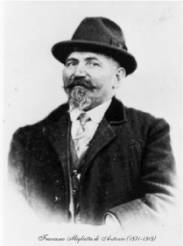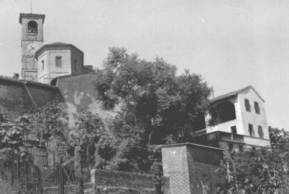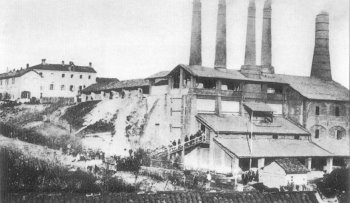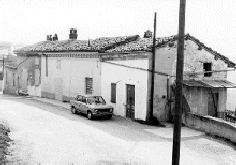
|
FRANCESCO, THE MAYOR... OF THE "COVO"
|

Francesco Miglietta
(1871-1918)
|
Francesco Miglietta (1871-1918)
Francesco was born in Serralunga di Crea (AL) on October 22, 1871.
His parents, Antonio from Torcello and Leonilda Surbone from Treville, worked for years as "schiavandai" (peasants) in some villages around Casale Monferrato, before becoming land owners in Treville. Here they bought many cultivated lands (wine, wood...), and, in 1888, they purchased houses at via Forno 6 and 11 (now via Marconi 11), located in Sant'Ambrogio Parish, for a sum of 1160 lira (less than $1 US).
When he was 25 years old, Francesco married his cousin Carolina Scagliotti (age 21), from the neighboring village of Quarti.
They had 5 children: 2 sons (who died as children) and 3 daughters: Enrichetta, Palmina my grandmother and Rosalia "Lia".
Besides continuing the agricultural activity of his father, he worked as oven boss in the furnace of the Italiana Cementi in Dionigi-Rollini (now hamlet of Ozzano Monferrato). In this establishment, nicknamed "Rabia", around 40 people from Treville and Quarti, were employed, thanks also to him.
|
|
Widowed when he was only 35 (Carolina died in 1906, immediately after Lia''s birth) Francesco wanted to give his small daughters a new mother.
Being esteemed and well-liked by everyone, many were eager to be his bride. Among them he chose Giuseppina (about 20 years old), the "beauty" of the village. They were married by a broker in a trevillese cowshed on July 19 1907.
The marriage immediately revealed itself to be a very bad "affair" for him. Giuseppina
A., in fact, besides being a bad mother (she is remembered in family as "the Stepmother"), above all aimed to lead a beautiful life and "to relieve" the patrimony of the "well-off" Francesco.
|

Part of Francesco's house and
the Saint Ambrogio Parish
|
|
Francesco in the meantime became an important man in village politics. Running as a Socialist, he became
Mayor of Treville in 1910; an office he held until his death.
He was a very beloved mayor because he offered financial help to the poor and often greeted, one by one, the "pupils" of the crowded primary school of Treville. Under his mandate via Forno was enlarged and the the massive bricks wall around the S. Ambrogio Parish was built [At that time via Forno was a very narrow road, that only allowed the carts hauled by a couple of cows to arrive in the Miglietta
and
Porta families's courtyards
. Now iit s the main road to the parish].

1884 - Italiana Cementi's furnaces in Dionigi-Rollini
He also built (or enlarged) the country road, along the ridge in front of Treville. So the workers from Treville, employed in the furnaces of Dionigi-Rollini and in the quarries of Quarti, could reach work more easily. The road connects the "Soliti" district with the Casale-Asti state road and passes near the small rural church of S. Quirico and among the farmhouses of the "Crosia" district.
|

Francesco's house in the '60s
|
Parties and lunches offered by him often developed in his courtyard. On these occasions, he uncorked his best wine, while guests danced waltzes, polkas and mazurkas.
In 1918 Francesco went to Genoa, where Enrichetta, his first-born daughter, worked, to meet his future son-in-law. The return journey was, unfortunately, fatal for him. On the train he met some soldiers, returning from the front and infected by "Spanish fever". He died of this illness, on the day of his 47th birthday (October 22, 1918), at 5 a.m.
|
|
After a very troubled period, his daughters went to live to Genoa and their "Stepmother" lived ignored in a nearby monferrino village until 1963. All of Francesco's properties, except his house, were sold off.
|
________________________________________________________
|
FRANCESCO AND THE "COVO"
On April 13, 1909 Francesco and other friends from Treville founded the Socialist Circle (at that time the party was not yet official). For this, they made a collection and bought, for 1450 italian liras, the small house in via Maestra 42 (now via Roma 13), belonging to Clerici Quirico.
The co-owners were: Allara Vittorio, Ariotti Giuseppe, Balbo Antonio, Allara Albino, Berrone Pietro, Caprioglio Giuseppe, Spinoglio Alfredo, Ariotti Pietro, Giordano Giuseppe, Miglietta Francesco, Defilippi Felice, Rei Riccardo, Allara Giovanni and Garrone Giuseppe.
The long notarial act, signed by Clerici Quirico, Allara Vittorio and Miglietta Francesco, says that the ownership will only be consolidated with the last surviving communist (strange term for a socialist group). When the (Socialist) Circle will be legally recognized, the majority will be able to deliberate the free move of the full building ownership and accessories to the same Circle."
|
|
During the following years the small house passed to other political associations (fascists, communists....), and last survivor's heir of the abovementioned list, was forgotten.
After many years, in the '70s, this place was in ruins and only one room, at street level, was usable. It was entrusted to a group of young people and there they founded their "Covo".
|

The "Covo" in the '70s
|
|
****
Only in the '90s, reading the old documents, left by my grandmother Palmina Miglietta, and searching in many archives, was I able to reconstruct the history of my ancestors Francesco Miglietta and Carolina Scagliotti. I discovered, not without much emotion, that the "Covo" had always been a particular point of reference in the life of Treville and was already part of my history?.
|